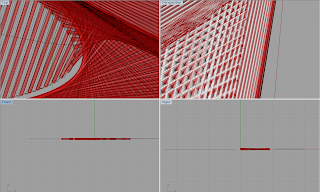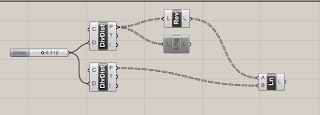Tuesday, March 29, 2011
Text for Poster
The theory of Spider Webs is able to represent and clarify a differing approach into natural formations and algorithmic concepts. The use of investigation into the diverse types of Spider Webs and the way in which some spiders have the ability to manipulate the web to whatever design, shape or function they want, clear illustrated the desire to assess and annotate this conception.
The first iteration deals with the evolution of the Spider web and the basis that creates the pattern and base structure that will eventually turn into the final conceptual aesthetics of the Spider Web.
The concept of growth can be represented with the second and third iterations as they demonstrate and represent the changing nature of the spider web can illustrate the pattern in a greater length. The use of the curve length slider displayed an opportunity to understand and grasp the way in which to increase the y and z axis. However it might represent a repetition towards the shape and design but within most spider webs the shape is consistent as the spider tries to ensure that its habitat is safe and can be used for most situations.
The fourth iteration can show increase of the curve length slider to 6 which will increase the slider to greater y and z axis heights. However in doing this it displays the increase in the geometry and creates more lines and shapes within the design. At the stage of the fifth iteration displays a slanted top view that can allow the viewer to see the growth and stage the spider web is up to. Within the sixth iteration the design principle and pattern is becoming clearer and can represent the shape and style that will carry out the final spiral design.
The seventh iteration can explore the growth and display how I tried to create a replica of an Argiope spider web design as they have most of their webs with a spider approach around them. The interesting concept with the iterations is that they didn’t only show growth but they also displayed new designs with can allow the user to cover more than one web design.
The eighth iteration showed the web in its spiral nature, the creation of the spiral spider web was produced to show a change within the natural formations of spider webs. It was a different approach that use of the curve length slider was able to adjust as the sine and cosine mathematical expressions created a spiral design. The ninth shows the growth of the web and the principles behind the increase of both the curve length and number of point’s iterations. This was quiet simple however the more iteration halt the system productive.
The tenth iteration principle can explore on the spiralling nature that the iterations allowed as the sliders where increase with adjustments to the curve lengths and number of points it can ensure that the web is increasing into another prominent shape and showing its final characteristics.
The eleventh and twelfth slider are similar to each other as they both explore the values of having the iterations of curve length and number of points being set onto the high regions of the sliders. When these sliders where displayed it became obvious that the concept of the spiral spider web has been achieved to and that the iterations explored were worthy in displaying the best outcomes for this design. However when increased the system productivity can reduce as its takes a while to render all the geometry to the correct algorithm’s and parameters that are set.
Overall, the purpose of the Spider Web was to show the process and growth of a spider web and how the use of technological systems can annotate and transform natural formations into design. The use of the Spider Webs can explore the domains of prosperity, protection, habitat and life.
Wednesday, March 23, 2011
Web Progress




Student Tutorial 1:
Understanding a web look on a flat surface



 Student 2:
Student 2:Dividing the length of the parameters for a curve and lines



Tutorial :
Helped with the understanding of sine curves and how curves and points can be manipulated to try and create a spider web form.
Wednesday, March 16, 2011
Theme Images
Tuesday, March 15, 2011
Exploration of Theme
http://designreform.net/2009/04/rhino-grasshopper-list-management/
Explanation of Spider Web Algorithm
"6.1.1 The SpiderWeb algorithm.
For each maximally connected set of hits within and with respect to a given 3-dimensional cube, we interpolate an interior articulation point AP (center of mass of all the hits in the set) and for each pair of adjacent hits in the set, we form a triangle consisting of AP and the two adjacent hits. We repeat this action for all cubes with hits.Note that in 2 dimensions the triangle degenerates to a segment connecting the 2 hits and the algorithm produces a set of contours satisfying the axioms.
In 3 dimensions this produces a collection of oriented 2-manifolds satisfying the axioms, consisting of triangles. In higher dimensions it can also be used to produce the correct manifolds. For example, in 4 dimensions it produces, within each hypercube, the two-dimensional boundary of each 3-dimensional surface patch of the manifolds that satisfy the axioms. We use the basic symmetries used in the proof of Theorem 1 to demonstrate the correctness for three dimensions, and suggest how the proof for higher dimensions would go."
Source : Computer Aided Surgery
Spider Web Architecture:
http://www.treehugger.com/files/2010/07/upcycled-speedo-pavilion-london.php
Wednesday, March 9, 2011
3 Concepts
 Source: http://picspicspics.co.cc/keyword/spider%20web%20art/
Source: http://picspicspics.co.cc/keyword/spider%20web%20art/ Source: http://picspicspics.co.cc/image/0b25679f/
Source: http://picspicspics.co.cc/image/0b25679f/2. Fractals
 Source: http://www.desktops-wallpapers.com/fractals.html
Source: http://www.desktops-wallpapers.com/fractals.html Source: http://picasaweb.google.com/Karsten.Jegstad/Fraktaler#
Source: http://picasaweb.google.com/Karsten.Jegstad/Fraktaler#3. Tree Branches
 Source: http://www.publicdomainpictures.net/view-image.php?image=2385&picture=tree-branches
Source: http://www.publicdomainpictures.net/view-image.php?image=2385&picture=tree-branches Source: http://www.etsy.com/listing/27819355/copper-tree-branch-connectors-100-pcs
Source: http://www.etsy.com/listing/27819355/copper-tree-branch-connectors-100-pcsTree branches are a life form that is constantly grow and evolving from the earth. With this in mind it would be nice to see a model that is growing from the land and meshing into the land.



























